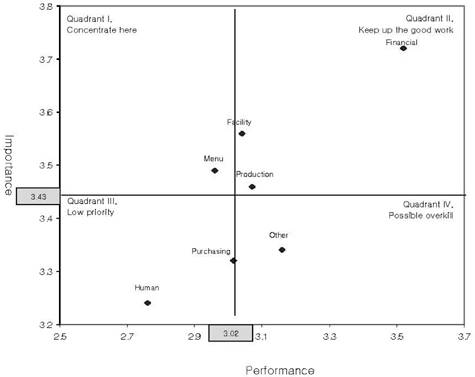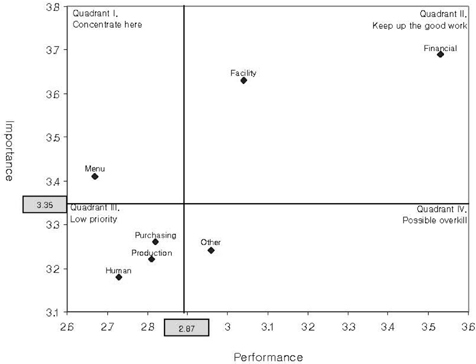Nutr Res Pract.
2009 Mar;3(1):49-55.
Comparison of foodservice management performance level between dietitians and non-dietitians in senior centers using IPA
- Affiliations
-
- 1Graduate School of Education, Myongji University, 50-3 Namgajwa-dong, Seodaemun-gu, Seoul 120-728, Korea.
- 2Department of LCB Hospitality Management, Sookmyung Women's University, 52 Hyochangwon-gil, Yongsan-gu, Seoul 140-742, Korea. yjy0823@sookmyung.ac.kr
Abstract
- This study investigated the management importance and performance level of foodservice managers at senior centers. Using the survey, perceived importance and performance levels of seven foodservice management areas were evaluated and analyzed. Data showed the foodservice facilities were being managed by dietitians (61.6%) or non-dietitians (38.9%). The result indicated that overall importance level (3.43) was higher than performance level (3.02) (p<.01). As of the IPA result, dietitians and non-dietitians had different perspectives in terms of managing the eight categories of foodservice areas. The differences in the IPA results between the two groups may reflect bias attributable to the respondents' degrees of knowledge and professional preparation. The research findings could enhance our understanding of importance of hiring professional dietitians to operate foodservice at senior centers and find out which management area should be concentrated for more effective foodservice management.
Keyword
MeSH Terms
Figure
Reference
-
1. Chang HJ. Strategies for the improvement of customer satisfaction on foodservice through identifying the foodservice quality factors in senior care facilities. Korean Journal of Community Nutrition. 2008. 13:69–79.2. Cho EH, Chang HJ, Kwak TK. Analysis of the job activities and demand of dietitian in the elderly health-care facilities. Journal of the Korean Dietetic Association. 2006. 12:313–328.3. Cho SH, Hong SY. Assessment of food service management in university food service. Journal of the Korean Society of Food Science and Nutrition. 1998. 14:482–491.4. Dowling RA, Lafferty LJ, Norton C. The management component of out profession. J Am Diet Assoc. 1990. 90:1065–1066.5. Han KH, Chai IS, Park JS, Choi MS, Chung SD. Evaluation of the menus of free meal service centers for home-bound elderly. Journal of the Korean Society of Food Culture. 2002. 17:584–593.6. Hanson RG. Considering "social nutrition" in assessing geriatric nutrition. Geriatrics. 1978. 33:49–51.7. Hong WS, Jang MR. The Assessment of Dietitian's Role Performance and Importance. Korean Journal of Food and Cookery Science. 1998. 14:124–133.8. Lafferty LJ, Dowling RA. Position of the American Dietetic Association: management of health care food and nutrition service. J Am Diet Assoc. 1997. 97:1427–1430.9. Lee JW, Kim KA, Lee MS. Nutritional intake status of the elderly taking free congregate meals compared to the middleincome class elderly. Korean Journal of Community Nutrition. 1998. 3:594–608.10. Lee YM, Lee KW, Myung CO, Park YS, Nam HW. Free congregate site meal service systems for elderly at urban area. Journal of the Korean Society of Dietary Culture. 1999. 14:431–446.11. Joo NM, Chon HJ. Analysis of the Foodservice Management in the Welfare Facilities for the Elderly. Korean Journal of Food and Cookery Science. 1997. 13:75–83.12. Jung HY, Yang IS, Chae IS, Lee HY. Analyzing the operational differences of foodservice center for homebound elderly by the presence of the dietitian. Journal of the Korean Dietetic Association. 2004. 19:197–204.13. Park KD, Kye SH, Jeoung EY. Investigation of Foodservice in some social welfare facilities in Seoul. Korean Journal of Dietary Culture. 1991. 12:87–96.14. Program for the Elderly at Community Centers. Journal of the Korean Dietetic Association. 19:333–344.15. Rim CS, Hwang JS, Kim JS. A Study on Research of Operating Status of Aged Classroom. Journal of Welfare for the Aged. 1999. 5:125–160.16. Suh HJ, Lee YN, Jang YA, Kim BH, Lee HS, Kim CI. Current Status and Management of Congregate Meal Service Program for the Elderly at Community Center. Journal of the Korean Dietetic Association. 2004. 3:333–344.17. Yang IS, Chae IS, Lee JM. Foodserivce management systems of home-delivered meal service program for home-bound elderly. The Korean Journal of Nutrition. 1998. 31:1498–1507.18. Yang IS, Chae IS, Yoo IG. Application of a PERT - Type System on Work Management in Home - Delivered Meals Service Program for Elderly. The Korean Journal of Nutrition. 2001. 34:701–714.19. Yang IS, Lee JM, Chai IS, Yoon J. Foodservice Management Systems at Elder - Care Sites for the Improvement of Elderly Welfare Policies in Korea. The Korean Journal of Nutrition. 1996. 31:1498–1570.20. Yoon JY, Messersmith AM. Foodservice systems management competencies of Korean dietitians: usage, perceived importance, and educational preparation. J Am Diet Assoc. 2002. 102:710–715.
- Full Text Links
- Actions
-
Cited
- CITED
-
- Close
- Share
- Similar articles
-
- TQM Performance and Job Satisfaction of Dietitians in Institutional Foodservices
- Analyzing the Operational Differences of Foodservice Center for Homebound elderly by the Presence of the Dietitian
- Importance Evaluation about the Remedies for Improvement of Sanitation Management by Foodservice Managers
- Job analysis and satisfaction of dietitians, nutrition teacher in school foodservice by school type in Gwangju and Jeonnam area
- School Dietitians' Satisfaction with and Needs for School Meal Service Support Centers




